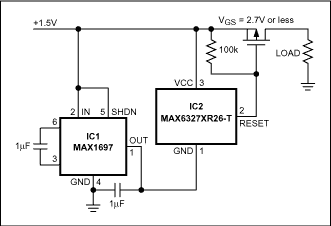Simple Circuit Disconnects Load from Low-Voltage Supply
Abstract
The following application note demonstrates a simple circuit using a charge pump and a microprocessor supervisor to disconnect a low voltage supply from a load. The circuit uses a P-channel MOSFET to disconnect the load from a 1.5V supply.
Power supplies often include a circuit that disconnects the load when the supply voltage drops too low (when a battery is nearly discharged, for example). A p-channel MOSFET connected between supply and load is the typical approach. However, a 1.5V single-cell battery or other low-voltage supply is not sufficient to fully turn on the MOSFET. For such low-voltage systems, consider the circuit of Figure 1.

Figure 1. This low-voltage circuit disconnects the load when the supply voltage drops below a predetermined threshold (1.3V in this case).
A small inverting charge pump (IC1) generates a negative voltage approximately equal to the input supply (VCC). That voltage connects to the ground terminal of a microprocessor supervisor (IC2), which monitors the voltage difference between its own VCC and GND pins. As long as this difference is greater than the supervisor's internal trip-voltage threshold, the RESET output voltage is driven to the charge-pump output (approximately -2VCC), which provides a gate-source voltage adequate to keep the MOSFET on. When the monitored voltage drops below the threshold of the supervisor, its RESET output goes up to VCC and turns the MOSFET off.
The supervisor shown has a threshold of 2.6V. Because the voltage it detects is twice the supply voltage, this circuit disconnects the load when the supply voltage drops below 1.3V, making it suitable for use with a typical 1.5V battery. Other internal threshold voltages are available.